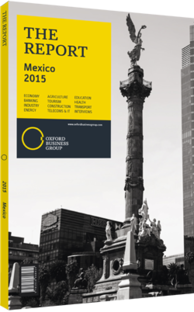Corporate bond market: Reforms set to drive new issues and boost liquidity
The corporate debt market in Latin America remains relatively small, and Mexico is no exception. As of December 2014, there was MXN1.02trn ($68.65bn) in outstanding corporate long-term bonds, including corporate, state, municipal and infrastructure issues, as well as those from state-owned companies and federal agencies. Corporate debt issuance has grown at a compound annual growth rate (CAGR) of 14.1% since 2009, increasing by 6.4% in 2013. Over the last five years alone, corporates have issued a combined MXN917bn ($61.71bn), for a CAGR of 8.1% over the period.
Sustained Growth
Recent years have seen more robust growth in the private long-term bond market, thanks in part to the approval of a structural reform package expected to boost economic growth and the country’s historically low monetary policy rate.
The year 2013 was the most active year to date for Mexican corporate bonds, with a total of MXN212bn ($14.27bn) issued, stemming from newcomers like infrastructure firm Fibra Uno; energy company IE nova; Aeroméxico; beverage giant Cultiba; as well as the frequent participation of the state-owned oil major Pemex and Federal Electricity Commission (Comisión Federal de Electricidad, CFE). Issues remained elevated in 2014 at MXN202.8bn ($13.65bn), though this was largely driven by Pemex and the CFE, which accounted for nearly half the overall total at MXN72.5bn ($4.88bn) and MXN15bn ($1bn), respectively.
Main Issuers
The market is still relatively concentrated, with 10 issuers accounting for 52.5% of the market as of August 2015. All 10 were rated “AAA” or its equivalent in the local scale except the state of Chihuahua (“A+”), which has only been able to place debt rated as “AA” or “AAA” in an enhanced structured fashion. State-owned Pemex and CFE represented 30.2% of outstanding long-term private debt, up 7.4% over end-2014, with Pemex accounting for the most outstanding issues, at MXN228.9bn ($15.4bn). This signals that state-owned companies – Pemex in particular – are raising funds for projects in the wake of the energy reform.
While the drop in oil prices will present a different operating environment in 2015, we expect corporate issuers will increase their participation ahead of the anticipated easing of interest rates in the US, which will likely prompt the Mexican central bank to do the same.
Besides Pemex and CFE, the main issuers in the Mexican corporate debt market are the low-income mortgage companies Fovissste and Infonavit, with 7% and 5% of issues, respectively; broadcaster Grupo Televisa with 2%; the Mexico City government, with 2%; Fibra Uno (1.7%); the state of Chihuahua (1.7%); telecoms firm América Móvil (1.4%); and highway concessionaire Red de Carreteras de Occidente (1.4%).
Market Structure
Unsecured issuances have substantially increased their share of the market and now make up 57.5% of the total outstanding volume, at MXN613.4bn ($41.3bn) as of August 2015, up from MXN284.2bn ($19.1bn) in 2009. On the other hand, structured issuances have declined from 51.9% in 2009 to 42.5%. Two structures in particular account for 37% of the total – asset-backed securities (ABS) and future flows. ABS are issues with a payment structure or mechanism whereby assets back the issue payment, with issue risk therefore depending on the quality of the assets and/or their management. Meanwhile, future flows serve as the source of payment for the second type, with risk dependent on the flows’ certainty and size.
Go Global
The minister of finance recently introduced three measures to improve the corporate debt market’s liquidity and depth. First, as of January 31, 2015, international investors will have access to peso-denominated corporate bonds through Euroclear, one of world’s largest settlement systems. Second, a new electronic platform named Subasec will help boost trade volumes, with development bank Nacional Financiera to serve as a liquidity window. Lastly, changes in tax regulations will allow foreign investors to avoid double taxation. Together, these will lower the cost of funding for local issuers, create more efficient bond pricing, and increase market participation and liquidity.
You have reached the limit of premium articles you can view for free.
Choose from the options below to purchase print or digital editions of our Reports. You can also purchase a website subscription giving you unlimited access to all of our Reports online for 12 months.
If you have already purchased this Report or have a website subscription, please login to continue.

